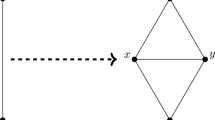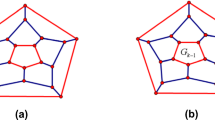Abstract
The planar Turán number of a graph H, denoted by \(ex_{_\mathcal {P}}(n,H)\), is the maximum number of edges in a planar graph on n vertices without containing H as a subgraph. This notion was introduced by Dowden in 2016 and has attracted quite some attention since then; those work mainly focus on finding \(ex_{_\mathcal {P}}(n,H)\) when H is a cycle or Theta graph or H has maximum degree at least four. In this paper, we first completely determine the exact values of \(ex_{_\mathcal {P}}(n,H)\) when H is a cubic graph. We then prove that \(ex_{_\mathcal {P}}(n,2C_3)=\lceil 5n/2\rceil -5\) for all \(n\ge 6\), and obtain the lower bounds of \(ex_{_\mathcal {P}}(n,2C_k)\) for all \(n\ge 2k\ge 8\). Finally, we also completely determine the exact values of \(ex_{_\mathcal {P}}(n,K_{2,t})\) for all \(t\ge 3\) and \(n\ge t+2\).










Similar content being viewed by others
Data Availability
There is no additional data associated with this paper.
References
Cranston, D., Lidický, B., Liu, X., Shantanam, A.: Planar Turán numbers of cycles: a counterexample. Electron. J. Combin. 29(3), 3.31 (2022)
Dowden, C.: Extremal \(C_4\)-free/\(C_5\)-free planar graphs. J. Graph Theory 83, 213–230 (2016)
Erdős, P., Stone, A.: On the structure of linear graphs. Bull. Am. Math. Soc. 52, 1087–1091 (1946)
Fang, L., Wang, B., Zhai, M.: Planar Turàn number of intersecting triangles. Discrete Math. 345(5), 112794 (2022)
Ghosh, D., Győri, E., Martin, R., Paulos, A., Xiao, C.: Planar Turàin number of the 6-cycle. SIAM J. Discrete Math. 36(3), 2028 (2022)
D. Ghosh, E. Győri, A. Paulos, C. Xiao, O. Zamora, Planar Turán number of the \(\Theta _6\)-cycle. arXiv:2006.00994v1
D. Ghosh, E. Győri, A. Paulos, C. Xiao, Planar Turán number of double stars. arXiv:2110.10515v2
M. Horňák, S. Jendrol\(^{\prime }\), I. Schiermeyer, R. Soták, Rainbow numbers for cycles in plane triangulations, J. Graph Theory 78(4), 248–257 (2015)
Lan, Y., Shi, Y., Song, Z.-X.: Extremal \(H\)-free planar graphs. Electron. J. Combin. 26(2), 2.11 (2019)
Lan, Y., Shi, Y., Song, Z.-X.: Extremal Theta-free planar graphs. Discrete Math. 342, 111610 (2019)
Lan, Y., Shi, Y., Song, Z.-X.: Planar Turán number and planar anti-Ramsey number of graphs. Oper. Res. Trans. 25(3), 200–216 (2021)
Turán, P.: On an extremal problem in graph theory. Mat. Fiz. Lapok. 48, 436–452 (1941)
Funding
Yongxin Lan was supported by the National Natural Science Foundation of China under Grant Nos. 12001154, 12161141006, Natural Science Foundation of Hebei Province under Grant No. A2021202025. Yongtang Shi was partially supported by the National Natural Science Foundation of China (No. 12161141006), the Natural Science Foundation of Tianjin (No. 20JCJQJC00090) and the Fundamental Research Funds for the Central Universities, Nankai University. Zi-Xia Song was supported by the National Science Foundation under Grant No. DMS-1854903.
Author information
Authors and Affiliations
Corresponding author
Ethics declarations
Conflict of interest
The authors declare that they have no conflict of interest.
Additional information
Publisher's Note
Springer Nature remains neutral with regard to jurisdictional claims in published maps and institutional affiliations.
Y. Lan: Supported by the National Natural Science Foundation of China under Grant Nos. 12001154, 12161141006, Natural Science Foundation of Hebei Province under Grant No. A2021202025. Y. Shi: Supported by the National Natural Science Foundation of China under Grant Nos. 11922112, 12161141006, Natural Science Foundation of Tianjin under Grant Nos. 20JCZDJC00840, 20JCJQJC00090. Z.-X. Song: Supported by the National Science Foundation under Grant No. DMS-1854903.
Appendix
Appendix
Proof of Lemma 2.1
Let G be given as in the statement. To establish the desired result, we first assume that there exists a vertex, say \(v_1\in V(G)\), such that \(v_1\) belongs to no triangle in G. Then \(e(G[N_G[v_1]])=3\). Let \(N_G(v_1)=\{v_2,v_3,v_4\}\) and \(A=V(G){{\setminus }}N_G[v_1]\). Then \(e_G(N_G(v_1),A)=6\) because G is a cubic graph. Hence, \(e(G[A])=e(G)-e(G[N_G[v_1]])-e_G(N_G(v_1),A)=3\), which implies that \(G[A]\in \{K_{1,3},P_{4},K_3\cup K_1\}\). Since G is cubic, we see \(G[A]\ne K_3\cup K_1\) by the planarity of G. That is either \(G[A]= K_{1,3}\) or \(G[A]= P_{4}\). If \(G[A]= K_{1,3}\) and \(x\in A\) is the center of \(K_{1,3}\), then \(G{{\setminus }}\{v_1,x\} = C_6\) and so \(G=G_1\). So we next assume that \(G[A]= P_{4}\). Let G[A] be a path with vertices \(v_5,v_6,v_7,v_8\) in order. We claim that \(v_6\) and \(v_7\) have no common neighbour in G. Suppose \(v_6\) and \(v_7\) have a common neighbour, say \(v_2\). Then \(N_G(v_3)=N_G(v_4)=\{v_1,v_5,v_8\}\) because G is a cubic graph. But then G has a \(K_{3,3}\)-minor with one part \(\{v_2,v_3,v_4\}\) and the other part \(\{v_1,\{v_5,v_6\},\{v_7,v_8\}\}\), a contradiction. Thus, \(v_6\) and \(v_7\) have no common neighbour in G. Without loss of generality, we may assume that \(v_6v_2,v_7v_3\in E(G)\). Notice that \(N_G(v_4)=\{v_1,v_5,v_8\}\) because G is a cubic graph. Then we see that either \(v_5v_2\in E(G)\) or \(v_5v_3\in E(G)\). If \(v_5v_3\in E(G)\), then \(v_8v_2\in E(G)\) and so G contains a \(K_{3,3}\)-minor with one part \(\{v_2,v_3,v_4\}\) and the other part \(\{v_1,\{v_5,v_6\},\{v_7,v_8\}\}\), a contradiction. Hence, \(v_5v_2\in E(G)\) and so \(v_8v_3\in E(G)\), which implies that \(G=G_2\).
Next we assume that every vertex in G belongs to at least one triangle. We claim that there must exist a vertex such that it belongs to two triangles. Suppose that every vertex in G belongs to exactly one triangle. Let \(v_1\in V(G)\). Then \(G[N_G[v_1]]= K_1+(K_2\cup K_1)\). Let \(A=V(G){{\setminus }}N_G[v_1]\). Then \(e_G(N_G(v_1),A)=4\) because G is a cubic graph. Hence, \(e(G[A])=e(G)-e(G[N_G[v_1]])-e_G(N_G(v_1),A)=4\), which implies that either \(G[A]= C_4\) or \(G[A]= K_1+(K_2\cup K_1)\). If \(G[A]= C_4\), there exist two vertices in A which does not belong to any triangle, a contradiction. If \(G[A]= K_1+(K_2\cup K_1)\), then there exists one vertex such that it belongs to either two triangles or no triangle, a contradiction. Thus, there must exist a vertex belonging to two triangles. Assume that \(v_1\) belongs to two triangles in G. Since G is \(K_4\)-free, we have \(G[N_G[v_1]]= K_4^-\). Let \(A=V(G){{\setminus }}N_G[v_1]\). Then \(e_G(N_G(v_1),A)=2\) because G is a cubic graph. Hence, \(e(G[A])=e(G)-e(G[N_G[v_1]])-e_G(N_G(v_1),A)=5\), which implies that \(G[A]= K_4^-\). Thus, \(G=G_3\). \(\square \)
Proof of Lemma 2.2
Let G be given as in the statement. Let v be an arbitrary vertex in G and \(V(G){{\setminus }}N_G[v]=\{v_1,v_2\}.\) Then \(v_1v_2\in E(G)\), else \(N_G(v_i)=N_G(v)\) for any \(i\in [2]\), which yields that \(G\cong K_{3,3}\). Since G is a cubic graph, we see that \(|N_{N_G(v)(v_i)}|=2\) for any \(i\in [2]\), and \(N_{N_G(v)}(v_1)\notin N_{N_G(v)}(v_2)\). Hence, \(G[N_G(v)]\cong K_2\cup K_1\), which implies that G is the graph given in Figure 2. \(\square \)
Rights and permissions
Springer Nature or its licensor (e.g. a society or other partner) holds exclusive rights to this article under a publishing agreement with the author(s) or other rightsholder(s); author self-archiving of the accepted manuscript version of this article is solely governed by the terms of such publishing agreement and applicable law.
About this article
Cite this article
Lan, Y., Shi, Y. & Song, ZX. Planar Turán Numbers of Cubic Graphs and Disjoint Union of Cycles. Graphs and Combinatorics 40, 28 (2024). https://doi.org/10.1007/s00373-024-02750-3
Received:
Revised:
Accepted:
Published:
DOI: https://doi.org/10.1007/s00373-024-02750-3




